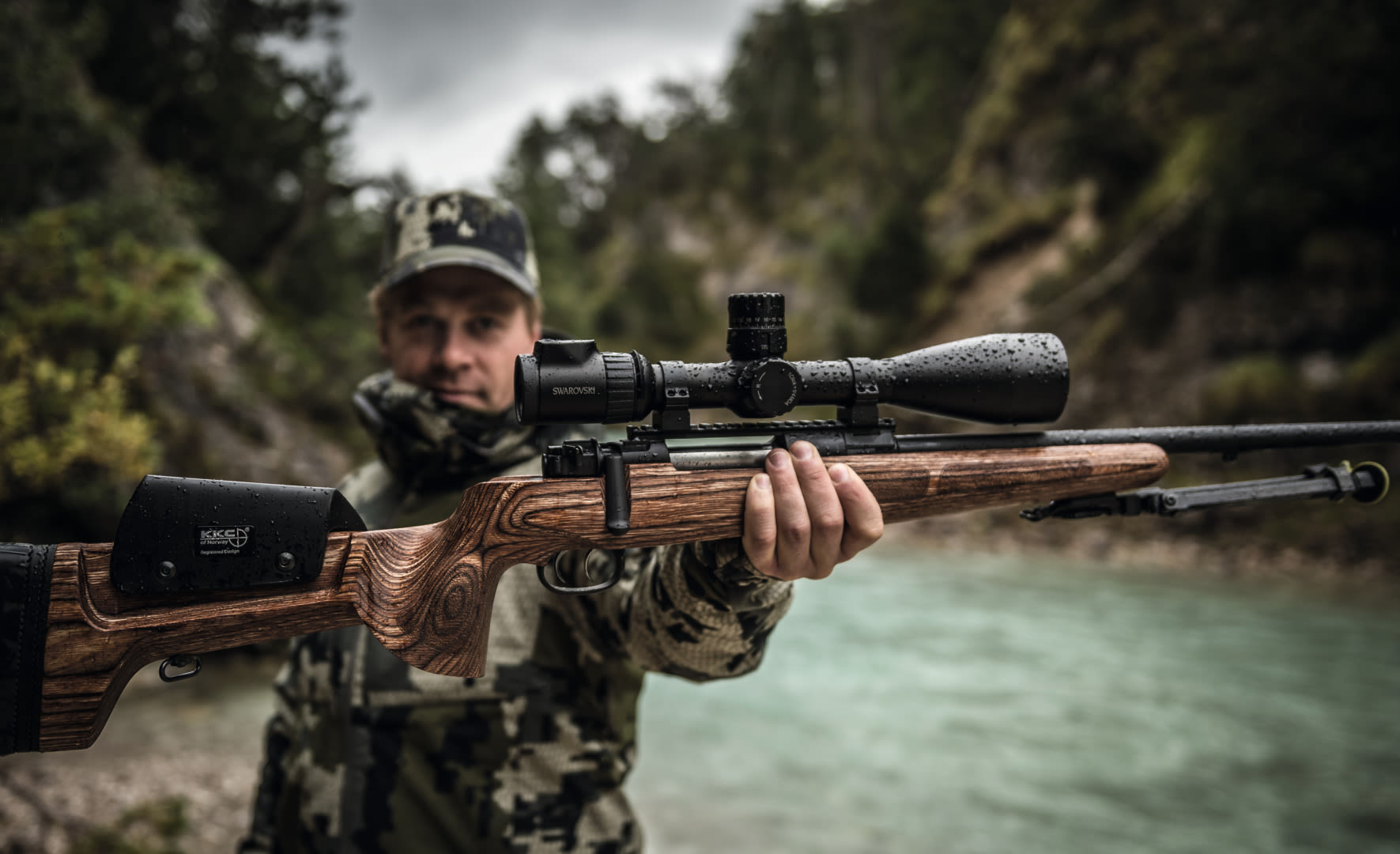Hunting has been a part of human culture for centuries, evolving from an essential survival activity into a recreational pursuit and a means of wildlife management. Whether seasoned or beginners, modern hunters rely on various tools to enhance their effectiveness, safety, and overall experience; among these tools, a hunting rifle scope is a crucial component, offering the precision and clarity needed to make accurate shots.
Why Is Choosing the Right Scope Important?
Selecting the best scope for hunting is essential for several reasons:
- Accuracy: A high-quality scope allows hunters to see their target more clearly, making it easier to aim accurately and take ethical shots.
- Versatility: Different hunting environments and targets require different scopes. Choosing the right one ensures adaptability to various conditions.
- Confidence: Using a scope that fits your hunting style boosts confidence, leading to a more enjoyable experience.
- Safety: A good scope can help distinguish between targets and the background, reducing the risk of accidents.
Whether targeting deer, elk, creatures, or waterfowl, selecting the proper scope is crucial in preparing for a successful hunt. This comprehensive guide will explore the factors to consider when choosing a scope, the available types, and the best practices for using them in the field.
Contents
Understanding Scope Specifications
Before diving into the types of scopes available for hunting, it’s essential to understand the basic specifications and features of a rifle scope. Knowing these elements will help you make an informed decision.
Magnification
Magnification is the first number you will encounter when looking at scope specifications. It indicates how much closer the target appears compared to the naked eye. For example, a scope with 3-9x magnification can magnify the target between 3 and 9 times.
- Fixed vs. Variable Magnification: Fixed magnification scopes have a single power setting, while variable magnification scopes offer a range of magnification levels. Variable scopes provide more flexibility, but fixed scopes are often lighter and more durable.
Objective Lens Diameter
The objective lens is at the front of the scope, and its size is measured in millimeters. A larger objective lens allows more light to enter the scope, resulting in a brighter image. However, larger lenses can also make the scope heavier and bulkier.
Reticle
The reticle, or crosshair, is the aiming point within the scope. There are several types of reticles:
- Duplex: Simple crosshairs are thicker on the outside and thinner in the middle, making it easy to focus on the target.
- Mil-Dot: Crosshairs with dots at regular intervals are used to estimate distance and adjust windage.
- BDC (Bullet Drop Compensator): Reticles with additional aiming points below the central crosshair to compensate for bullet drop at various distances.
Eye Relief
Eye relief is the distance between your eye and the scope where you can see the entire field of view. More extended eye relief is essential for safety, especially with high-recoil rifles.
Field of View
The field of view (FOV) is the width of the area you can see through the scope at a given distance, typically measured in feet at 100 yards. A wider FOV is beneficial for tracking moving targets.
Parallax
Parallax is the apparent movement of the reticle when you move your head. Some scopes have adjustable parallax settings, which can enhance accuracy at long distances.
Types of Scopes for Hunting
With a basic understanding of scope specifications, let’s explore the different types of scopes available for hunting and their ideal applications.
Rifle Scopes
Rifle scopes are the most common type of scope used in hunting and come in various configurations to suit different needs.
Best Use:
Big Game Hunting – A rifle scope with variable magnification (e.g., 3-9x or 4-12x) is ideal when hunting deer, elk, or moose. These scopes offer flexibility for different shooting distances, from close-range shots in thick brush to longer shots across open fields.
Recommended Features:
- Variable Magnification: Provides versatility for various hunting scenarios.
- Large Objective Lens: A 40-50mm lens ensures a bright image in low-light conditions.
- BDC Reticle: Helps compensate for bullet drop at long distances.
- Coated Lenses: Enhances light transmission and reduces glare.
Example:
The Vortex Optics Crossfire II is a popular choice for big game hunters. It offers a 3-9x magnification, a 40mm objective lens, and a Dead-Hold BDC reticle for accurate shots at various distances.
Shotgun Scopes
Shotgun scopes are designed specifically for use with shotguns. They offer lower magnification and wider fields of view to accommodate the shorter ranges typical in shotgun hunting.
Best Use:
Turkey Hunting—A scope with 1-4x magnification is often sufficient for turkey hunting, as turkeys are usually shot at close ranges.
Recommended Features:
- Low Magnification: A 1-4x magnification provides a wide field of view.
- Compact Design: Lightweight and easy to handle in dense cover.
- Durable Construction: Shockproof and waterproof to withstand the recoil and elements.
Example:
The Leupold VX-Freedom 1.5-4x20mm is an excellent option for turkey hunters. It is compact, offers generous eye relief, and has a simple reticle for quick target acquisition.
Handgun Scopes
Handgun scopes are designed for hunting with pistols, offering unique features to handle handguns’ recoil and shooting style.
Best Use:
Small Game Hunting – Handgun scopes are suitable for small game hunting, where precision and quick target acquisition are crucial.
Recommended Features:
- Intermediate Magnification: A 2-7x magnification range provides versatility for different distances.
- Extended Eye Relief: Ensures a safe distance from the handgun’s recoil.
- Lightweight: Easy to mount and carry on a pistol.
Example:
The Burris Handgun, 2-7x32mm scope, is popular among handgun hunters. It offers extended eye relief, variable magnification, and a durable design.
Red Dot Sights
Red dot sights are non-magnifying optics that use a red dot as an aiming point. They are ideal for quick target acquisition and are often used on firearms like shotguns, rifles, and handguns.
Best Use:
Varmint Hunting – Red dot sights are effective for varmint hunting, where speed and precision are essential.
Recommended Features:
- Unlimited Eye Relief: Allows for quick and flexible target acquisition.
- Wide Field of View: Ideal for tracking fast-moving targets.
- Battery Life: Look for models with long-lasting batteries.
Example:
The Aimpoint PRO (Patrol Rifle Optic) is a famous red dot sight known for its ruggedness, long battery life, and clear reticle.
Long-Range Scopes
Long-range scopes are designed for precision shooting at extended distances. They are often used in environments where shots can be taken over 500 yards.
Best Use:
Elk or Moose Hunting – A long-range scope with high magnification is essential in open terrain where long shots are standard.
Recommended Features:
- High Magnification: 6-24x or higher magnification for long-distance accuracy.
- Adjustable Parallax: Reduces parallax error at long distances.
- Tactical Turrets: Allows for quick and precise adjustments.
Example:
The Nightforce SHV 5-20x56mm scope is a top choice for long-range hunters. It offers exceptional clarity, high magnification, and precise turrets for dialing in shots.
Factors to Consider When Choosing a Hunting Scope
With various scopes available, selecting the right one depends on several factors matching your hunting needs.
Hunting Environment
- Dense Woods: To track targets in thick cover, opt for scopes with lower magnification and a wide field of view.
- Open Fields: High magnification scopes are better suited for spotting and shooting at long distances.
Game Type
- Big Game: Requires scopes with variable magnification to accommodate different shooting distances.
- Small Game: Precision is vital, so consider scopes with precise reticles and sound-light transmission.
Budget
- Entry-Level Scopes: Affordable options often have fewer features but can still be effective for casual hunting.
- Mid-Range Scopes: Offer a good balance of quality and features for most hunters.
- High-End Scopes: Premium scopes with advanced features and exceptional clarity are ideal for serious hunters.
Weight and Size
- Compact Scopes: Easier to carry and handle, especially in dense environments.
- Larger Scopes: Provide better light transmission but can add weight to your rifle.
Brand Reputation
- Established Brands: Consider reputable brands known for their quality and customer support.
- Billings Optics: As a scope and sight manufacturer, Billings Optics offers a range of scopes designed for hunting and other shooting sports. Their products are known for their durability and performance.
Best Practices for Using a Hunting Scope
Knowing how to use it effectively is essential once you’ve chosen the proper scope for your needs.
Proper Mounting
Ensure your scope is securely mounted to your rifle. A loose scope can lead to missed shots and potential damage. Follow the manufacturer’s instructions for mounting and use quality rings and bases.
Zeroing Your Scope
Zeroing, or sighting in, your scope is the process of aligning the reticle with the bullet’s point of impact at a specific distance. This is crucial for accuracy.
- Start at a Short Distance: Begin at 25 yards and adjust the scope to hit the center of the target.
- Move to a Longer Distance: Once zeroed at a short range, move to your desired hunting distance (e.g., 100 yards) and make further adjustments.
Understanding Bullet Trajectory
- Know Your Ammo: Different ammunition types have varying ballistic trajectories. Understand how your chosen ammo behaves at different distances.
- Use a BDC Reticle: If your scope has a BDC reticle, familiarize yourself with the drop points for different distances.
Practice in Realistic Conditions
- Simulate Hunting Scenarios: Practice shooting in conditions similar to those you’ll encounter while hunting, such as low light or from a tree stand.
- Test Different Positions: Practice shooting from various positions, including standing, kneeling, and prone.
Maintenance and Care
- Clean Regularly: Keep your scope clean and free of debris. Use a lens cloth to wipe the lenses and a soft brush for the body.
- Check for Damage: Inspect your scope for any signs of damage, such as dents or scratches, and ensure all screws are tight.
Expert Insights on Hunting Scopes
Choosing the proper hunting scope requires more than understanding specifications and features. Let’s explore expert insights and advice that can help refine your decision-making process.
Balancing Magnification and Field of View
Expert Tip: While high magnification is tempting for long-range shooting, it can limit your field of view and make it harder to track moving targets. Opt for a scope with adjustable magnification to balance clarity and target acquisition.
Importance of Quality Glass
Expert Insight: The quality of the glass used in a scope significantly affects its performance. Premium lenses with multi-coating provide better light transmission, reducing glare and enhancing image clarity, especially in low-light conditions.
The Role of Parallax Adjustment
Expert Advice: A parallax adjustment feature can be crucial for long-range shooting. It ensures that the reticle remains stable on the target regardless of eye movement, leading to more accurate shots.
Reticle Selection Based on Hunting Style
Expert Suggestion: Choose a reticle that complements your hunting style. A duplex reticle is excellent for general hunting, while a mil-dot reticle can be beneficial for calculating bullet drop and windage at varying distances.
Durability and Weather Resistance
Expert Recommendation: Consider scopes that are waterproof, fog-proof, and shockproof. These features ensure reliability and performance in diverse weather conditions and rugged terrains.
Popular Brands in the Hunting Scope Market
When choosing a hunting scope, it’s helpful to be familiar with some of the leading brands in the market known for their innovation and quality.
Vortex Optics
Overview: Vortex Optics offers a wide range of scopes for different hunting needs. They are known for their durability, quality optics, and lifetime warranty.
Popular Model: The Vortex Viper PST Gen II is renowned for its excellent optics, tactical turrets, and versatile reticle options.
Leupold
Overview: Leupold has been a leader in the optics industry for decades, offering high-quality, durable, and reliable scopes.
Popular Model: The Leupold VX-5HD is favored for its crystal-clear glass, Twilight Max HD light management system, and rugged design.
Nikon
Overview: Although Nikon has exited the riflescope market, its scopes are still popular due to their affordability and quality of optics.
Popular Model: The Nikon ProStaff series remains a favorite for many hunters, offering reliable performance and great value.
Burris
Overview: Burris provides a variety of scopes with advanced features and solid construction, catering to hunters and tactical shooters alike.
Popular Model: The Burris Fullfield IV is praised for its robust build, clear optics, and versatile magnification range.
Billings Optics
Overview: Billings Optics is an emerging player in the hunting optics market known for its innovative designs and commitment to quality.
Popular Model: The Billings Optics Precision Hunter offers an impressive combination of clarity, durability, and user-friendly features.
Future Trends in Hunting Scopes
As technology advances, hunting scopes evolve, offering hunters new features and capabilities. Here are some trends shaping the future of hunting optics.
Digital Scopes
Trend Insight: Digital scopes are becoming more popular. They offer features like rangefinders, ballistic calculators, and night vision capabilities. These scopes provide hunters with advanced tools for improved accuracy and adaptability.
Integration with Smart Devices
Trend Insight: Some modern scopes now offer connectivity with smartphones and other devices, allowing hunters to record video, take photos, and access ballistic data in real-time.
Lightweight and Compact Designs
Trend Insight: Manufacturers are focusing on creating lighter and more compact scopes without sacrificing performance. These designs make it easier for hunters to carry their gear, especially on long treks.
Enhanced Durability
Trend Insight: As hunting environments become more challenging, the demand for rugged, durable scopes increases. Manufacturers are incorporating materials and coatings that enhance resistance to weather, impact, and wear.
Conclusion
Choosing the best scope for hunting involves understanding your specific needs, preferences, and hunting conditions. Whether you’re pursuing a big game in open fields or a small game in dense forests, there’s a scope tailored to your requirements. Consider factors such as magnification, reticle type, and budget, and remember that practice and familiarity with your equipment are essential to successful hunting.
By staying informed about the latest advancements and trends in scope technology, you can ensure that your hunting experiences are rewarding and ethical. Embrace the art and science of hunting with a scope that complements your skills and enhances your connection to the natural world.
FAQs
What type of scope is best for hunting in low-light conditions?
For low-light conditions, a scope with a larger objective lens (40-50mm) and high-quality multi-coated lenses will provide better light transmission, resulting in a brighter and clearer image. Look for scopes with good low-light performance ratings.
Can I use a red dot sight to hunt big game?
While red dot sights are excellent for quick target acquisition and short to medium distances, they may not be ideal for big game hunting, where precision at longer ranges is required. A variable magnification scope is usually more suitable for big game hunting.
How do I maintain my hunting scope?
Regular maintenance includes:
- Cleaning the lenses with a soft cloth.
- Checking for loose screws.
- Ensuring that the scope is stored in a protective case when not used.
Avoid exposing the scope to extreme temperatures and moisture.
What is parallax, and how does it affect shooting accuracy?
Parallax occurs when the reticle moves about the target when the shooter’s eye moves. Adjustable parallax scopes allow hunters to eliminate this error, improving accuracy, especially at longer distances.
Are there any legal restrictions on using specific scopes for hunting?
Some regions have regulations on using specific optics, such as electronic scopes or night vision. Always check local hunting laws and regulations to ensure compliance with legal requirements.




